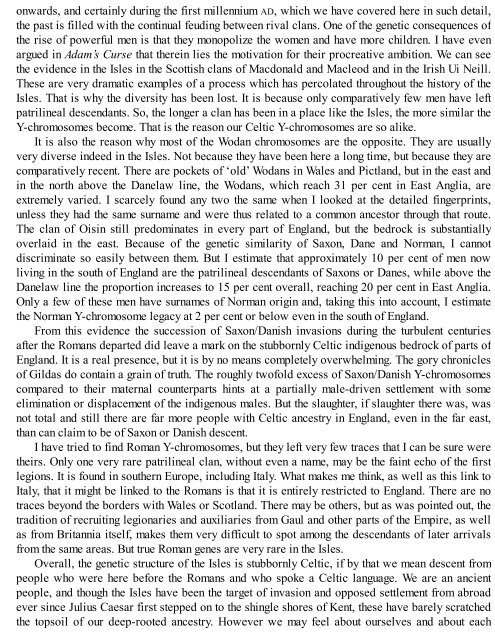Create successful ePaper yourself
Turn your PDF publications into a flip-book with our unique Google optimized e-Paper software.
onwards, and certainly during the first millennium AD, which we have covered here in such detail,<br />
the past is filled with the continual feuding between rival clans. One of the genetic consequences of<br />
the rise of powerful men is that they monopolize the women and have more children. I have even<br />
argued in Adam’s Curse that therein lies the motivation for their procreative ambition. We can see<br />
the evidence in the Isles in the Scottish clans of Macdonald and Macleod and in the Irish Ui Neill.<br />
These are very dramatic examples of a process which has percolated throughout the history of the<br />
Isles. That is why the diversity has been lost. It is because only comparatively few men have left<br />
patrilineal descendants. So, the longer a clan has been in a place like the Isles, the more similar the<br />
Y-chromosomes become. That is the reason our Celtic Y-chromosomes are so alike.<br />
It is also the reason why most of the Wodan chromosomes are the opposite. They are usually<br />
very diverse indeed in the Isles. Not because they have been here a long time, but because they are<br />
comparatively recent. There are pockets of ‘old’ Wodans in Wales and Pictland, but in the east and<br />
in the north above the Danelaw line, the Wodans, which reach 31 per cent in East Anglia, are<br />
extremely varied. I scarcely found any two the same when I looked at the detailed fingerprints,<br />
unless they had the same surname and were thus related to a common ancestor through that route.<br />
The clan of Oisin still predominates in every part of England, but the bedrock is substantially<br />
overlaid in the east. Because of the genetic similarity of Saxon, Dane and Norman, I cannot<br />
discriminate so easily between them. But I estimate that approximately 10 per cent of men now<br />
living in the south of England are the patrilineal descendants of Saxons or Danes, while above the<br />
Danelaw line the proportion increases to 15 per cent overall, reaching 20 per cent in East Anglia.<br />
Only a few of these men have surnames of Norman origin and, taking this into account, I estimate<br />
the Norman Y-chromosome legacy at 2 per cent or below even in the south of England.<br />
From this evidence the succession of Saxon/Danish invasions during the turbulent centuries<br />
after the Romans departed did leave a mark on the stubbornly Celtic indigenous bedrock of parts of<br />
England. It is a real presence, but it is by no means completely overwhelming. The gory chronicles<br />
of Gildas do contain a grain of truth. The roughly twofold excess of Saxon/Danish Y-chromosomes<br />
compared to their maternal counterparts hints at a partially male-driven settlement with some<br />
elimination or displacement of the indigenous males. But the slaughter, if slaughter there was, was<br />
not total and still there are far more people with Celtic ancestry in England, even in the far east,<br />
than can claim to be of Saxon or Danish descent.<br />
I have tried to find Roman Y-chromosomes, but they left very few traces that I can be sure were<br />
theirs. Only one very rare patrilineal clan, without even a name, may be the faint echo of the first<br />
legions. It is found in southern Europe, including Italy. What makes me think, as well as this link to<br />
Italy, that it might be linked to the Romans is that it is entirely restricted to England. There are no<br />
traces beyond the borders with Wales or Scotland. There may be others, but as was pointed out, the<br />
tradition of recruiting legionaries and auxiliaries from Gaul and other parts of the Empire, as well<br />
as from Britannia itself, makes them very difficult to spot among the descendants of later arrivals<br />
from the same areas. But true Roman genes are very rare in the Isles.<br />
Overall, the genetic structure of the Isles is stubbornly Celtic, if by that we mean descent from<br />
people who were here before the Romans and who spoke a Celtic language. We are an ancient<br />
people, and though the Isles have been the target of invasion and opposed settlement from abroad<br />
ever since Julius Caesar first stepped on to the shingle shores of Kent, these have barely scratched<br />
the topsoil of our deep-rooted ancestry. However we may feel about ourselves and about each
















